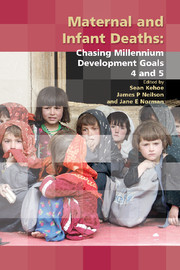Book contents
- Frontmatter
- Contents
- Participants
- Declaration of personal interests
- Preface
- The Millennium Development Goals
- SECTION 1 THE SIZE OF THE PROBLEM
- SECTION 2 CLINICAL PROBLEMS AND SOLUTIONS – MATERNAL
- 5 Postpartum haemorrhage
- 6 Reducing deaths from hypertensive disorders of pregnancy
- 7 Obstructed labour (including partograms)
- 8 Puerperal sepsis in low- and middle-income settings: past, present and future
- 9 Unsafe abortion and strategies to reduce its impact on women's lives
- 10 HIV and tuberculosis
- 11 A pragmatic approach to safe anaesthesia
- SECTION 3 CLINICAL PROBLEMS AND SOLUTIONS – NEONATAL
- SECTION 4 TRAINING AND DEVELOPMENT
- SECTION 5 SPECIFIC CHALLENGES IN SPECIFIC COUNTRIES
- SECTION 6 CONSENSUS VIEWS
- Index
8 - Puerperal sepsis in low- and middle-income settings: past, present and future
from SECTION 2 - CLINICAL PROBLEMS AND SOLUTIONS – MATERNAL
Published online by Cambridge University Press: 05 February 2014
- Frontmatter
- Contents
- Participants
- Declaration of personal interests
- Preface
- The Millennium Development Goals
- SECTION 1 THE SIZE OF THE PROBLEM
- SECTION 2 CLINICAL PROBLEMS AND SOLUTIONS – MATERNAL
- 5 Postpartum haemorrhage
- 6 Reducing deaths from hypertensive disorders of pregnancy
- 7 Obstructed labour (including partograms)
- 8 Puerperal sepsis in low- and middle-income settings: past, present and future
- 9 Unsafe abortion and strategies to reduce its impact on women's lives
- 10 HIV and tuberculosis
- 11 A pragmatic approach to safe anaesthesia
- SECTION 3 CLINICAL PROBLEMS AND SOLUTIONS – NEONATAL
- SECTION 4 TRAINING AND DEVELOPMENT
- SECTION 5 SPECIFIC CHALLENGES IN SPECIFIC COUNTRIES
- SECTION 6 CONSENSUS VIEWS
- Index
Summary
Introduction
Puerperal sepsis is an infective condition in the mother following childbirth and one of the leading causes of maternal mortality worldwide. It is the third most common cause of maternal death as a result of childbirth, after haemorrhage and abortion, accounting for as much as 15% of the 500000 maternal lives lost annually. In low-and middle-income countries, infections occurring in the puerperium are reportedly the sixth leading cause of disease burden for women in their reproductive years. Complications in the mother such as secondary postpartum haemorrhage and infertility can result, and there is an association with early-onset neonatal sepsis.
Reducing puerperal sepsis in women will contribute to achieving Millennium Development Goals (MDGs) 4 and 5 on child survival and maternal health. Despite the importance of puerperal sepsis globally, there is surprisingly little current interest in the condition. Even in industralised countries such as the UK, although deaths from puerperal sepsis are now rare, the latest Confidential Enquiry into Maternal Deaths suggests that the incidence of complications is increasing and failure of clinicians to recognise signs and symptoms of puerperal sepsis have contributed to maternal mortality.
In developing countries, puerperal sepsis continues to cause many unnecessary deaths, mainly because of inadequate access to care during childbirth and poor quality of care. Women may not be able to reach health professionals during labour and delivery care provided in the home setting with attendants who lack the necessary skills can increase the risk of infection.
- Type
- Chapter
- Information
- Maternal and Infant DeathsChasing Millennium Development Goals 4 and 5, pp. 131 - 148Publisher: Cambridge University PressPrint publication year: 2010
- 10
- Cited by

